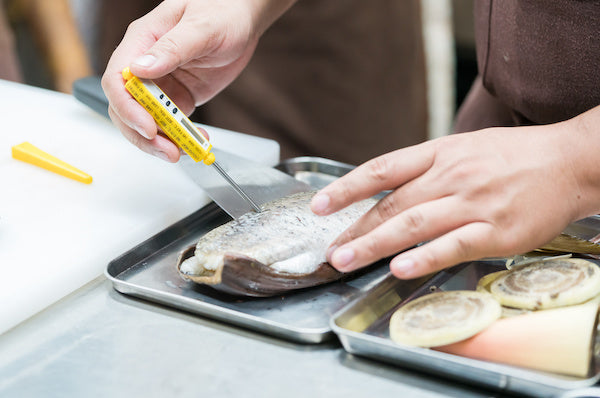
How do you know if your fish is cooked, and what are the proper internal temperatures to know whether it’s done?
Cooking fish to its proper internal temperature is crucial for both safety and taste.
- For wild salmon, the optimal range is 120F to 125F, resulting in moist and flaky fillets. Cooking salmon above this range can result in dry and tough meat.
- Pacific halibut should be cooked to an internal temperature of 130F to 135F for optimal appearance and taste. Undercooked halibut can be chewy and unpleasant, while overcooked halibut can be dry and tough.
- Pacific cod should be cooked to an internal temperature of 130F to 135F for firm and flaky fillets. Cooking cod below or above this range can result in rubbery or mushy fish.
- Black Cod (Sablefish) needs to be cooked to an internal temperature of 135F. But cooking slightly above this temperature does not harm this forgiving fish.
Proper Internal Temperature of Wild Salmon
As seafood enthusiasts, we always find it challenging to achieve the perfect balance between a flaky and moist salmon fillet. However, there's one simple way to make sure the fish is cooked to perfection: maintaining the proper internal temperature. The internal temperature range for a wild salmon fillet should fall between 120F to 125F. In this section, we'll discover the benefits of cooking wild salmon slightly underdone and the optimal internal temperature range for a juicy and flaky fish. We'll also explore the implications of cooking wild salmon above the recommended temperature range and how it affects the texture and taste of the fish.
Benefits of cooking wild salmon slightly underdone
Cooking wild salmon slightly underdone has numerous advantages that cannot be overlooked. It retains moisture and allows for a flakier texture of the fillet, it preserves the natural flavor and nutritional profile of the fish, and prevents overcooking, which leads to dryness and a rubbery texture.
Results of cooking wild salmon above optimal temperature range
Overcooked salmon: when you've turned a delicacy into a delicacy for the seagulls. Cooking wild salmon above the optimal temperature range can result in dry and rubbery fillets. The results of cooking wild salmon beyond the ideal internal temperature of 120F to 125F can cause the natural oils and fats to break down, making the fillet lose its flavorsome taste and moist texture. It is crucial to maintain control over fish's internal temperatures while cooking to prevent it from becoming overcooked.
How to Know When Halibut is Cooked
When it comes to Pacific halibut, perfection is key – cook it just right to enjoy its buttery texture and delicate flavor. The Pacific Halibut should be cooked to an internal temp of 130F to 135F.
In this segment, we will guide you through the ideal internal temperature range for Pacific Halibut fillets, the corresponding doneness level, and the consequences of overcooking or undercooking this delicate fish. Join me as we dive into the nuances of cooking perfect Pacific Halibut fillets.
Ideal doneness level and appearance of Pacific halibut fillets
For Pacific halibut fillets, achieving an ideal level of doneness is crucial for optimal taste and texture. Halibut fillets should be just cooked through with a translucent and moist appearance. Overcooking can lead to dryness and toughness in the texture.
It's important to note that the unique thickness of halibut fillets can make it difficult to gauge internal temperature accurately. Using a meat thermometer inserted into the thickest part of the fillet can help ensure proper doneness. In fact, according to cookbook author Mark Bittman, "The most reliable method to judge fish doneness is with a thermometer."
Consequences of cooking halibut below or above optimal temperature range
Cooking halibut below or above its optimal internal temperature range can lead to significant consequences. Undercooking the halibut fillets can result in a raw and translucent texture, which is not desirable for consumption. On the other hand, if the fish is cooked above its optimal temperature range, it can become dry and tough, losing its flavor and texture. It is crucial to maintain the right temperature while cooking halibut for delicious flavor and optimal health benefits.
Overcooked or undercooked halibut fillets can lead to undesirable consequences. Overcooked halibut loses its tenderness and becomes dry and tough, leading to reduced acceptability of taste and texture.
It is critical to monitor the internal temperature during cooking- Halibut fillets should be cooked at an Internal temperature between 130°F - 135°F till they flake easily with a fork. This ensures they are tender yet retain their inherent flavors.
Finding the perfect internal temperature for Pacific cod can feel like trying to solve a complex math equation, but it's worth it for that delicious, flaky texture.
Cooking Pacific Cod to the Proper Temperature
Pacific Cod is one of the most sought after and delicious fish out there. That's why it's important to know the optimal internal temperature for firm and flaky fillets of Pacific Cod. The internal temperature range of 130F to 135F provides the best results.
It's essential to note that cooking fish above or below the recommended range can result in overcooked or undercooked fish. Overcooking results in dry and chewy fish, while undercooking can lead to foodborne illness. Since fish fillets differ in thickness, gauging their doneness precisely can be challenging without an accurate thermometer.
Proper Internal Temperature for Black Cod (Sablefish)
As avid fish connoisseurs, one of our favorite types of fish to prepare is sablefish. This unique fish has a distinct flavor and texture that makes it stand out from other types of fish. In order to fully appreciate and enjoy this delicacy, it’s essential to understand the recommended internal temperature for sablefish. In this section, I will share two key sub-sections: the unique characteristic of sablefish and the recommended internal temperature, as well as the forgiving nature of sablefish and its ability to cook past its optimal temperature. Let’s dive into the details and unlock the secrets to perfectly cooked sablefish!
Unique characteristic of Black Cod
Black Cod has a unique forgiving nature and can be cooked past the optimal internal temperature range without compromising its quality. Cooking Black Cod beyond the recommended 135F internal temperature results in a more firm texture, but it still maintains its delicate flavor and moisture. This is due to Sablefish's high-fat content, which keeps the fish moist even when cooked under unfavorable conditions.
As opposed to other fish species that suffer from dryness and toughness when overcooked, sablefish remains palatable even after being accidentally left in the oven for a little extra time. Its inherent oily composition gives chefs extra flexibility while cooking, allowing them to experiment with different recipes and adjust internal temperature based on preference.
The best way to determine doneness when cooking seafood is by using a food thermometer. Some types of seafood may have unique characteristics, such as sablefish, which only require one temperature reading of exactly 135 degrees Fahrenheit. Always remember that carryover cooking can raise the internal temperature as well, so it is essential to monitor and adjust accordingly.
What is Carryover (or residual) Cooking, and How Does it Affect Internal Temperature?
It’s so disappointing take a perfectly cooked fish out of the oven, and it immediately begins to dry out or become overcooked. This issue can often be attributed to a lack of understanding of carryover cooking. In this segment, we will explore what carryover cooking entails and provide a comprehensive definition. We’ll also look at how cooking surfaces, methods, and tools affect the internal temperature of the fish. Lastly, we’ll offer some tips on adjusting the temperature to achieve the desired doneness. As we go through this, keep in mind that getting a fish's internal temperature right is crucial to achieving the perfect texture and taste.
Definition and explanation of carryover cooking
Carryover cooking is a phenomenon where the internal temperature of meat continues to rise even after it is taken off heat. It occurs due to residual heat transferring from the outer layers of the meat to its core. Carryover cooking is common in fish and seafood as they have a low thermal mass and are prone to drying out. Fishermen and chefs must consider carryover cooking when determining the optimal internal temperature of fish.
When determining how long one should cook fish, carryover cooking becomes an important consideration. One must take into account that the fish will continue to cook even after being removed from heat. This means that it is crucial not to overcook meat or risk a dry or tough texture. Cooks can avoid overcooking by removing the meat from heat slightly ahead of reaching their desired internal temperature.
A pro tip when it comes to carryover cooking and preventing overcooking is understanding that different types of fish have varying levels of thermal mass. For example, thicker cuts like halibut require more time for carryover cooking while longer, thinner varieties like cod require less time for carryover cooking. By observing these variations in thermal mass, chefs can adjust their timing and remove proteins from heat early enough to prevent overcooking without sacrificing desired doneness levels.
From grilling to sous-vide, different cooking methods mean different internal temperatures- so choose wisely!
Cooking surfaces and methods have a significant impact on the internal temperature of fish. For instance, the heat source, cookware material, and cooking time can affect the degree of doneness and quality of your fish.
Maintaining the appropriate internal temperature is critical to achieve desired doneness when cooking seafood. Here are four steps to help adjust the temperature based on carryover cooking and achieve optimal results:
- Determine the ideal temperature range for the specific type of fish being “cooked.
- Monitor the internal temperature throughout cooking using a meat thermometer.
- Use a lower heat source or remove from heat slightly before reaching the desired internal temperature to account for carryover cooking.
- Allow fish to rest off heat for a few minutes before serving to reach full doneness while avoiding overcooking.
- Unique factors such as fish thickness, cooking method, and personal preference must be considered when adjusting the temperatures based on carryover cooking for different types of fish.
Avoid overcooking by paying close attention to carryover cooking in addition to monitoring internal temperature while cooking seafood. Adjusting temperatures appropriately will result in perfectly cooked, flavorful seafood every time- Don't miss out on achieving optimal results with these tips for adjusting temperature based on carryover cooking to achieve desired doneness.
For wild salmon, internal temperatures anywhere between 120F and 125F will produce a medium-rare doneness that is flaky and moist. If you cook wild salmon above this range of internal temperature, you can expect the fillets to be drier in texture with a firmer flake.
How can I tell if my fish is cooked to the desired internal temperature?
The optimal internal temperature of fish varies by species, but using an instant-read thermometer is the most accurate way to determine if a fillet is cooked to the desired temperature. Alternatively, you can use a fork to check if the fish is firm and easily flakes apart, nearly opaque in their centers for medium doneness.
← Older post Newer post →

